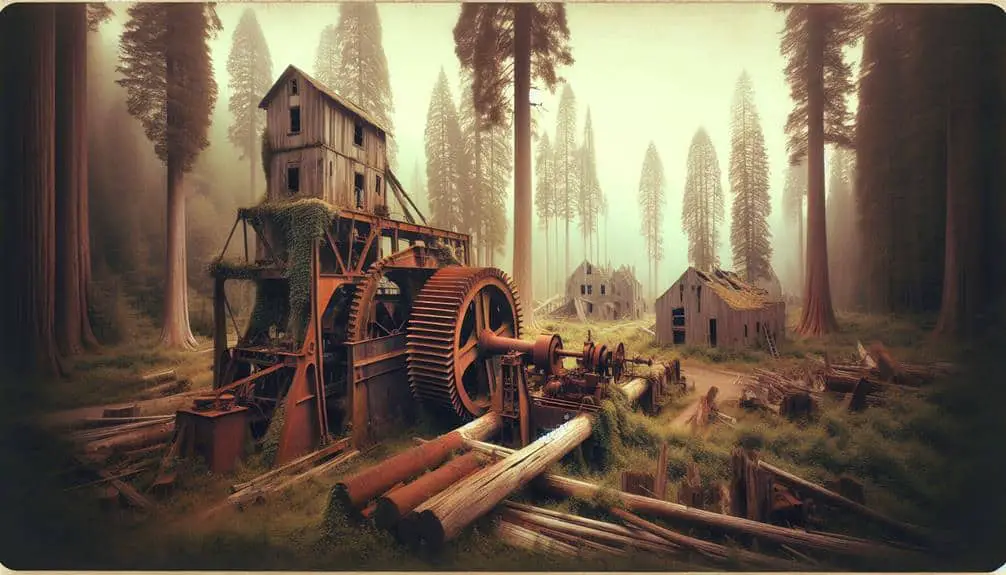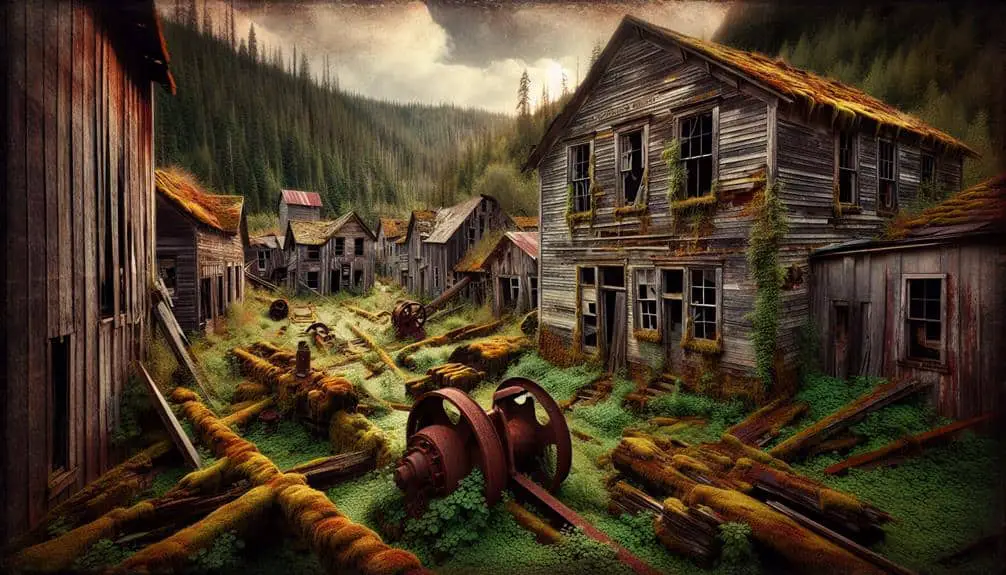Discover the tale of abandoned logging towns in the US. Economic shifts, environmental effects, and the past glory of once-thriving communities intertwine. Crumbling sawmills bear witness to the economic toll. Nature reclaims deserted streets and structures, a proof of forgotten hardships. Woodsmen and families shared a legacy of resilience and community bonds amidst harsh conditions. Infrastructure decay mirrors neglect and the passage of time. Rotting relics stand as echoes of an industrial era now past. The silent ruins hint at a story of hard work, perseverance, and eventual abandonment. Abandoned logging towns hold a historic narrative worth exploring further.
Key Points
- Deforestation led to soil erosion and habitat destruction.
- Economic migration caused skilled laborers to leave struggling communities.
- Abandoned sawmills and crumbling structures reflect economic decline.
- Nature reclaims land, showing environmental consequences.
- Historical preservation efforts capture the essence of these once-thriving towns.
Rise and Fall of Logging Communities
The rise and fall of logging communities across the United States showcase a complex interplay of economic, environmental, and social factors that have shaped the landscape of these once-thriving towns. Logging, once a booming industry, left a lasting impact on the environment. The sheer scale of deforestation led to soil erosion, habitat destruction, and disrupted ecosystems.
Economic migration played a pivotal role in the rise and fall of these logging towns. As the demand for timber fluctuated and industries shifted, workers followed the promise of new opportunities elsewhere. This migration of skilled laborers often left behind struggling communities with dwindling resources.
The environmental consequences of unchecked logging practices combined with the ebb and flow of economic opportunities ultimately led to the decline of many logging towns. Understanding the intricate connections between these factors is fundamental in unraveling the story behind the abandoned logging towns scattered across the United States.
Abandoned Sawmills and Empty Streets
Exploring the desolate remnants of abandoned sawmills and deserted streets reveals a haunting narrative of a once vibrant industry now lost to time and neglect. The economic impact of these abandoned sawmills is evident in the crumbling structures that once echoed with the sounds of productivity. The environmental consequences linger as nature slowly reclaims the land, intertwining with rusted machinery and decaying buildings.
Despite the desolation, signs of community resilience peek through the overgrowth. Empty streets that once bustled with life now stand as a proof of the perseverance of those who called these towns home. Historical preservation efforts are essential in capturing the essence of these abandoned places, ensuring that the stories of the past aren't forgotten.
As you wander through the silent sawmills and streets, you can't help but wonder about the lives that were once intertwined with this now eerie landscape. The juxtaposition of past prosperity and present abandonment paints a poignant picture of the rise and fall of these logging communities.
Forgotten Woodsmen and Families
Amidst the abandoned logging towns of the US, the forgotten woodsmen and families left behind a legacy shrouded in mystery and resilience. As you explore the lost history of these vanished communities, you uncover tales of struggle and strength, painting a vivid picture of a bygone era.
- Generations of Toil: Woodsmen and their families dedicated their lives to the forests, enduring harsh conditions and long hours to provide for their loved ones. The stories of their perseverance echo through the silent woods.
- Community Bonds: In these isolated towns, a sense of camaraderie flourished among the woodsmen and their families. They relied on each other for support, forming tight-knit bonds that withstood the test of time.
- Legacy of Resilience: Despite facing countless challenges, the woodsmen and their families persevered, leaving behind a legacy of resilience that continues to inspire. Their determination to carve out a living from the land serves as a tribute to the human spirit's indomitable nature.
As you investigate the lives of these forgotten pioneers, you uncover a tapestry of courage, sacrifice, and unwavering dedication that deserves to be remembered.
Decay of Logging Town Infrastructure
Amid the remnants of these once-thriving logging towns, the gradual deterioration of infrastructure mirrors the fading echoes of a once bustling industry. As you explore these abandoned sites, you'll notice the structural integrity of buildings compromised by time and neglect. Roads that once buzzed with activity are now overgrown and cracked, reclaiming the land they once traversed. The iconic sawmills and warehouses, once symbols of prosperity, now stand as weathered relics of a bygone era.
Urban exploration enthusiasts are drawn to these decaying towns, capturing the beauty of decay through their lenses. However, the importance of historical preservation can't be overstated. Preserving these sites allows us to learn from our past, honoring the labor and sacrifices of those who built these communities from the ground up.
In your exploration of these haunting landscapes, you witness the delicate balance between nature's reclamation and the efforts of historical preservationists. It's a poignant reminder of the transient nature of industry and the resilience of the human spirit.
Echoes of Industry in Ruins
The remnants of the once-thriving logging industry in the abandoned towns of the US serve as poignant echoes of an industrial era now in ruins. As you wander through these forgotten places, you can't help but feel the weight of history pressing down on you.
- Nature Reclaiming: Amidst the decaying buildings and rusted machinery, nature slowly but surely reclaims its territory. Trees sprout from rooftops, and vines crawl up walls, blurring the lines between civilization and wilderness.
- Whispers of the Past: The silence that hangs heavy in the air speaks volumes about what once was. Each creaking floorboard and peeling paint chip whispers stories of hard work, perseverance, and ultimately, abandonment.
- Rust and Ruin: Rusty sawmills and dilapidated warehouses stand as proof of a bygone era when these structures thrummed with the sounds of progress. Now, they stand as haunting reminders of industrial remnants left to decay, a stark contrast to the bustling hubs they once were.
In these lost heritage sites, the echoes of industry reverberate through time, reminding us of the rise and fall of entire communities built on the promise of logging.
Frequently Asked Questions
What Impact Did the Decline of Logging Towns Have on the Surrounding Environment and Wildlife?
When logging towns decline, ecosystems suffer. Wildlife habitats face disruptions, leading to imbalances in nature. By understanding these impacts, you can see the interconnectedness between human activities and the environment, emphasizing the need for sustainable practices.
How Did the Abandoned Logging Towns Affect Local Economies and Nearby Communities?
In the aftermath of their abandonment, the former logging towns left a trail of economic repercussions and strained community relationships. The social dynamics shifted, and the question of historical preservation loomed large, creating a complex legacy.
Are There Any Efforts Being Made to Preserve or Restore These Abandoned Logging Towns?
Efforts are underway to preserve and restore abandoned logging towns for historical preservation and community revitalization. These initiatives also aim to tap into tourism opportunities and safeguard cultural heritage, breathing new life into these once-thriving communities.
What Role Did Government Policies and Regulations Play in the Downfall of Logging Communities?
Government policies and environmental regulations were like a double-edged sword for logging towns. While some rules aimed to protect forests, they often led to economic downfall by limiting timber access and imposing costly compliance measures, exacerbating community decline.
How Have the Descendants of Former Woodsmen and Families Who Lived in These Towns Been Affected by Their Abandonment?
As descendants of former woodsmen and families from abandoned logging towns, you've been profoundly affected by the loss of your heritage and community. Preserving cultural heritage is essential to honoring your history and identity.



